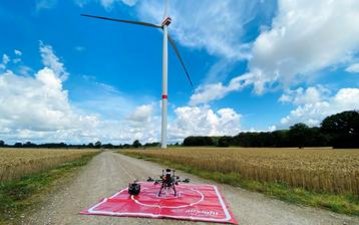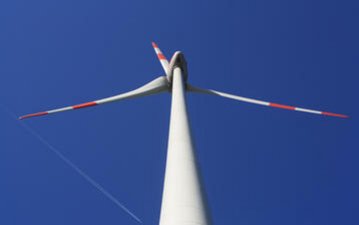Wind turbines may represent hazards to low-flying aircraft. Therefore, significant obstacle are required to be marked and lighted at night.
Typical obstacle lighting at night consists out of either red permanent or red flashing lights, irrespective of an aircraft being nearby or not. The lighting of wind turbines at night, however, is often negatively perceived by the local neighborhood.
Consequently, an autonomous aircraft detection system may be installed so that obstacle lighting is activated only when aircraft are nearby.
First States such as Germany require the equipage of wind turbines with an aircraft detection lighting system (ADLS) already, more States prepare themselves to enable ADLS as an option to enhance the acceptability of wind turbines by the people.
Since April 2020 airsight has been entitled by the German Federal Ministry of Transport (BMDV, previously BMVI) as authorized entity to verify aircraft detection lighting systems (ADLS).
airsight supports ADLS manufacturers as well as project developers with the site-specific verification of the local implementation facilitating the approval process.


For the commissioning of an aircraft detection lighting systems (ADLS), a verification of the local implementation is necessary. Generally, this analysis should consist out of the following aspects:
- review of aeronautical elements
- review of technical implementation
- review of administrative matters
The review of the aeronautical elements shall determine the feasibility of an ADLS for a particular location as well as basic conditions for the system from an aeronautical perspective. Elements which should be considered include amongst others:
- aerodromes and helicopter landing sites
- visual flight procedures, such as traffic patterns, routes, and reporting points
- (military) low flying areas and routes
- controlled airspaces
The main scope of the technical implantation’s review is assurance of the proper coverage of the detection zone by the ADLS as well as the interface to the lighting system within the wind park. The coverage of the detection zone will be assessed considering the identified aeronautical elements. Also, the implementation of the ADLS into the windpark’s lighting system architecture needs to be reviewed carefully. The proper functions of the ALDS’ aircraft detection capabilities need to be verified.
Furthermore, administrative matters need to be verified. Depending on local requirements, amongst others the ADLS manufacturer should have a quality management system implemented to at least ISO 9001 standards. Also, the ADLS manufacturer should have agreements with the lighting system interface manufacturer and with the wind park operator, the latter for assurance of the on-going operations of the ADLS as well as for monitoring the environment which may have an impact to the ADLS.

As an entitled organization by the German Federal Ministry of Transport (BMDV, previously BMVI, airsight verifies the design and functionality of aircraft detection lighting systems (ADLS).
The aim of the type certification is to ensure that the ADLS meet all the requirements of the relevant regulations and satisfy the high safety standards of aviation. The wide-ranging criteria focus on the safety, quality and reliability of the ADLS.
Not only the design of the ADLS is examined, but also its functionality during a flight validation campaign for demonstration installations on existing wind turbines.
The flight validation, on the one hand, is performed utilizing a "conventional aircraft". In addition, a drone equipped with sophisticated technology is used to review all relevant flight altitudes.
Together with the manufacturer Lanthan Safe Sky, the type certification for the first ADLS based on the reception and evaluation of transponder signals was successfully completed. In a process lasting several months, Lanthan Safe Sky was able to provide all the evidence required for testing the system development and functionality.
Deutsche Windtechnik Steuerung GmbH was also able to complete the type certification of its ADLS in close cooperation with airsight.

Do you have a project that you'd like to discuss with us?
Send us a message, we will review your request and get back to you!



